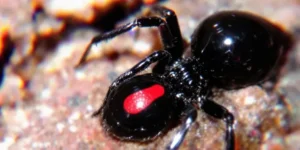Are you concerned about redback spider bites? These small Australian spiders can deliver a painful sting. Redback spiders live throughout Australia, in urban and rural areas alike.
This blog will help you identify redbacks and understand the steps to take if bitten. Continue reading to protect yourself from these venomous arachnids!
Key Takeaways
- Redback spiders are small but dangerous Aussie arachnids. Females are 10 mm long with a black body and red stripe. Males are smaller at 3-4 mm.
- These spiders live all over Australia in warm, sheltered spots near homes. They’re also found in other countries like New Zealand and Japan.
- A redback bite causes severe pain and sweating. It can lead to nausea, headaches, and breathing issues. Seek medical help right away if bitten.
- First aid includes using an ice pack and avoiding pressure bandages. Doctors may give antivenom, which has been used since 1956.
- To control redbacks, clean your garden, seal entry points, use sticky traps, and apply insecticide. Natural deterrents like peppermint oil can also help.

Description of the Redback Spider

Redback spiders are small yet dangerous Australian arachnids. Females are larger, measuring about 10 mm in length, with a black body and a red stripe on top. They have a bright red hourglass shape on their underside.
Males are significantly smaller, only 3-4 mm long. They’re light brown with white marks and a pale hourglass underneath.
Juvenile redbacks have a different appearance compared to adults. They have additional white marks on their bodies. As they mature, these marks fade away. The redback’s scientific name is Latrodectus hasselti.
It belongs to the same family as the black widow spider. Both are recognised for their potent venom and distinctive markings.
Habitat and Distribution
Redback spiders are native to Australia. They inhabit various regions across the country, from urban centres to rural areas. These arachnids prefer warm, sheltered locations near human dwellings.
They often reside in sheds, beneath outdoor furniture, and within stacks of firewood.
These spiders have also established populations in other countries. They’ve been found in New Zealand, Japan, and Belgium. In certain locations, such as England, they’re confined to heated greenhouses.
However, in places like the UAE and New Guinea, they flourish in outdoor environments. In Australia, they’re frequently encountered in cities such as Brisbane, Perth, and Alice Springs.
It’s wise to be aware of these eight-legged creatures in your outdoor spaces!
Venom and Symptoms of a Bite
Redback spider venom is highly potent. It contains a neurotoxin called alpha-latrotoxin. This toxin causes severe pain and other serious effects. Female redbacks carry 0.08–0.10 mg of venom.
That’s enough to cause significant harm. In mice, the lethal dose is 0.27–0.91 mg/kg.
A redback bite results in a set of symptoms known as latrodectism. Victims experience intense local pain and profuse sweating. They might also experience nausea, vomiting, headaches, and severe distress.
In rare cases, complications can arise. Some people experience seizures or respiratory difficulties. Pulmonary oedema is another rare but serious complication. If you suspect a redback bite, seek immediate medical attention.
First Aid and Treatment
First aid and treatment for Redback spider bites are crucial. Quick action can ease pain and prevent serious harm.
- Apply an ice pack to the bite area to reduce pain and swelling.
- Avoid using a pressure bandage as it can make the venom spread faster.
- Seek medical help immediately, even if symptoms appear mild initially.
- Doctors may administer antivenom, which has been in use since 1956.
- Only 2-20% of bite cases require antivenom, typically within 24 hours.
- Antivenom can be administered through a muscle or vein injection.
- Most people tolerate antivenom well, but some may experience side effects.
- About 5% of people have rapid reactions to the antivenom.
- Severe allergic responses occur in 1-2% of cases.
- Serum sickness, a delayed reaction, occurs in 10% of patients.
- Doctors will monitor for any adverse reactions to the treatment.
- Pain relief drugs may help manage discomfort from the bite.
- Rest and remain calm to slow the spread of venom in your body.
- Follow-up care is essential to ensure full recovery from the bite.
Controlling Redback spider populations is essential to prevent bites from occurring.
Managing Redback Spider Infestation
Redback spiders can be a significant issue for Australian homeowners. Here’s how to manage these problematic arachnids:
- Clean up your yard. Remove old junk, wood piles, and leaf litter where spiders tend to hide.
- Seal entry points. Inspect for gaps around doors, windows, and pipes. Use caulk to close them up.
- Use sticky traps. Position these in dark corners and under furniture to catch spiders.
- Apply insecticide. Use it on spider-prone areas, but adhere to the label instructions carefully.
- Keep your home dry. Repair leaky taps and pipes to reduce moisture that attracts spiders.
- Trim plants near your house. This eliminates spider hiding spots and entry points.
- Use natural deterrents. Peppermint oil or vinegar can help discourage spiders.
- Vacuum regularly. This removes spiders and their webs from your home.
- Consult professionals. For significant infestations, pest control experts can assist.
- Inspect your shoes and clothes. Redbacks prefer dark spots, so shake out items before use.
- Install screens on windows and doors. This prevents spiders from entering while allowing fresh air in.
- Remove spider webs. Use a broom to clear away webs as soon as you notice them.
Supplementary details on Redback Spider
Redback spiders have an intricate life cycle, distinctive mating behaviours, and a significant cultural influence in Australia. Explore these captivating aspects of the redback spider’s existence and background.
Reproduction and Life Cycle
Redback spiders have a unique life cycle. Female redbacks can live up to 2-3 years, while males only survive 6-7 months. Females grow bigger and take longer to mature, needing 75-120 days.
Males mature faster in just 45-90 days. This significant difference in lifespan means females often outlive their mates.
Breeding is dangerous for male redbacks. Females can store sperm for up to 2 years after mating. They then lay 4-10 egg sacs, each holding about 250 eggs. In just 8 days, tiny spiderlings hatch.
These baby spiders are aggressive and often eat each other. The survivors then float away on silk threads to find new homes. We’ll now examine the predators that hunt these spiders.
Predators and Natural Enemies
After exploring redback spider reproduction, we’ll examine their predators. Redback spiders face several natural enemies. Black house spiders, cellar spiders, and giant daddy-long-legs spiders frequently hunt redbacks.
These predators contribute to controlling redback populations.
Wasps also contribute to redback population control. A particular wasp species, Agenioideus nigricornis, targets redback eggs. This wasp deposits its eggs near redback egg sacs. Upon hatching, the wasp larvae consume the redback eggs.
This natural process aids in balancing the redback population in their natural habitat.
Historical and Cultural Impact
The redback spider has made a significant impact on Australian culture. In 1973, Slim Newton’s song “The Redback on the Toilet Seat” became popular. It made light of the spider’s tendency to hide in toilets.
The spider also inspired the naming of a beer and a boot brand. Cricket enthusiasts recognise it as the emblem of the South Australia team.
Art has also incorporated the redback. In 1996, a large spider sculpture appeared in Eight Mile Plains, Queensland. Ten years later, Australia Post featured the spider on a stamp. However, they had to withdraw it due to public concerns.
These instances demonstrate how this small spider has become a significant part of Australian life.
Comparison Table: Redback Spider vs. Black Widow Spider
Redback spiders and black widow spiders share many traits, but they’re not identical. Here’s a comparison of these two venomous arachnids:
| Feature | Redback Spider | Black Widow Spider |
|---|---|---|
| Appearance | Black (or brownish), red/orange stripe on upper abdomen, scarlet hourglass marking underneath | Glossy black, red hourglass marking on the underside of the abdomen |
| Venom Quantity | 0.08–0.10 mg | Varies by species |
| Lethal Dose (LD50) in Mice | 0.27–0.91 mg/kg | Varies by species |
| Location | Australia | North and South America, Europe, Asia, Africa |
| Web Structure | Messy, tangled webs | Irregular, three-dimensional webs |
| Size (Female) | 1 cm body length | 1.5 cm body length |
Both spiders can cause harm to humans. Seek help if bitten. For more info on redback spiders, visit RedBackSpider.com. Be cautious in areas where these spiders live.
Redback Spider: Examining the Australian Latrodectus Hasselti, Its Bite, and Poisonous Potential
If you’ve ever worried about encountering a redback spider in your backyard, this blog is for you. Unveiling its bite, venom effects, and origins, it’s worth reading because these eight-legged creatures can pose serious risks for unsuspecting Australians.
Spider Venom & the Redback Spider’s Threat
Many female redback spiders guard their female’s web waiting for a male spider to approach. Their fang delivers potent poison, and the venom acts directly on nerve endings. Some say the katipo from New Zealand is closely related. The upper side of the abdomen in a red-back spider typically displays a red to orange stripe, and if the spider is disturbed, a redback spider bite can happen in seconds.
For a male redback or male redback spiders, life is short: each male is very small and might become entangled in the web or also eat their siblings. Meanwhile, female spider individuals lay several batches of eggs over a period of up to two months. Found throughout australia, these spiders spin dry silk with run to ground attachments.
Records of the western australian archives reveal that the western australian museum and western australian museum supplement detail many bites. The australian redback spider belongs to the family theridiidae. A bite site can produce redback spider envenoming, sometimes requiring redback spider antivenom. Yet recent trials show antivenom is controversial: data suggests the show antivenom has a low success rate, low response rate little better than placebo—the effect is less than might be expected.
Katipo references appear in australian geographic, highlighting that a red or orange pattern or stripe on the upper abdomen is the common name clue for a red back spider. Some individuals have white markings on the upper or markings on the upper side, especially the smaller male.
| Spider Feature | Details |
|---|---|
| Species Name (Thorell) | Latrodectus hasselti (aka redback spider) |
| Typical Abdomen Size | Size of a large pea |
| Notable Traits | Distinctive red or orange stripe |
| Habitat | Female’s web, trapdoor spiders vicinity |
| Danger Level | Bites cause symptoms may escalate (e.g. systemic symptoms) |
- Poison severity ranges from mild to intense.
- Many bites produce local pain, but some develop systemic symptoms.
- Male somersaults might occur as the male courts the female.
- Sacks between september and may hold egg sacks that can spawn many spiderlings.
Conclusion
Redback spiders pose a significant risk in Australia. Their bite can result in intense discomfort. Stay calm and informed to ensure your safety. Recognise these spiders and their webs.
If bitten, promptly seek medical attention. Through awareness and caution, we can coexist safely with these Australian arachnids.
FAQs
1. What’s a redback spider, and where do you find them in Oz?
Redbacks are… well, nasty little buggers. They’re black with a red stripe on their back – hence the name. You’ll spot ’em all over Australia, but they love hiding in dark, quiet spots. Think sheds, dunny seats, and old shoes.
2. How bad is a redback bite, really?
It’s no walk in the park, mate. The venom can cause serious pain, sweating, nausea, and vomiting. In rare cases, it might even lead to more severe symptoms. But don’t panic – deaths are extremely rare these days.
3. What should I do if a redback takes a nibble?
First things first, stay calm. Apply an ice pack to the bite area to ease the pain. Then, get yourself to a hospital or call emergency services. They’ll sort you out with the right treatment, which might include antivenom if needed.
4. Can I keep these eight-legged terrors away from my place?
Too right, you can! Keep your yard tidy, clear out clutter, and seal up cracks in walls and foundations. Shake out your shoes before putting them on, and be careful when reaching into dark spaces. A bit of caution goes a long way in avoiding these venomous critters.





